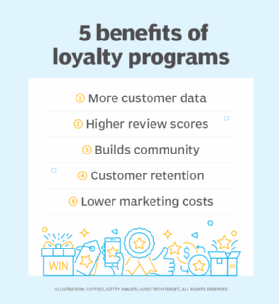
Getty Images/iStockphoto
Why are loyalty programs important?
Loyalty programs can help organizations retain their most valuable customers with special offers. Additionally, they can gather useful marketing data, increase referrals and more.
Customers aren't the only ones who love loyalty programs -- marketers love them, too.
Loyalty programs drive customer retention, which can help organizations generate revenue, increase referrals and achieve overall growth. Organizations typically generate most of their revenue from existing customers, which requires less overhead than revenue from new customers. While organizations should still invest in customer acquisition, repeat business is ideal.
In addition to improved customer retention, loyalty programs also collect valuable customer data and firsthand feedback from customers. Marketing teams can use this data to derive customer insight and optimize CX. Given the many benefits of loyalty programs, CX leaders who haven't already done so should consider one for their organization.
What is a loyalty program?
A loyalty program is a customer retention strategy that recognizes and rewards customers who do business with a company repeatedly. Organizations should personalize their programs for customers and provide a human touch with regular outreach via phone, email, voicemail or SMS.
Although marketing teams must generate leads and sell products to new prospects, loyalty programs also play a role in their marketing strategies. To improve the adoption and retention of loyalty program members, marketing teams must use the creativity and knowledge of their customer bases to promote the programs effectively.
Marketers also must revise, improve and -- in many cases -- simplify their loyalty programs. When successful, the program itself becomes a reason prospects become customers. For example, if word gets out through marketing -- or even more cleverly, through customer referrals on social media -- that a retailer provides a 20% discount to loyalty program members, that alone could entice prospects to become repeat customers.
The best loyalty programs compel customers to buy from organizations over their competitors, even when the competitors offer cheaper products and services. For example, passengers often get seat upgrades and early boarding privileges in airline loyalty programs. That may be enough for customers to pay an extra $30 for a flight. Also, the loyalty miles add up to free flights and higher levels within the program, offering even more benefits, such as first-class upgrades or entry to airport clubs.

5 benefits of loyalty programs
Loyalty programs benefit marketers as much as they benefit customers. Organizations can expect the following benefits from their loyalty programs.
1. More customer data
Once a customer joins a loyalty program, marketing teams can track their preferences, buying habits and interests. In fact, most Americans are willing to trade personal information for loyalty program perks, according to Forrester Research. Organizations can use this data to personalize outreach and customize monthly offers to different customer personas.
2. Use the customer's voice
Rather than develop many new marketing campaigns, marketers can rely on their rewards program members to drive more business. Organizations can ask customers to review the company or program on third-party sites. Successful loyalty programs often delight customers so much that they feel compelled to share their experiences on social media, which can bring in new business and loyalty members.
3. Community building
Many people want to feel like they're a part of something larger than themselves, and loyalty programs can offer that. Virtual events, live events and online forums can foster communities and discussions from which marketing teams can receive firsthand customer feedback.
4. Improved customer retention and referrals
Loyalty programs reward repeat customers with exclusive offers and personalized treatment, such as coupons and birthday gift cards, which drive customer retention. Loyal customers often tell their friends and family about the program's special offers, which brings in new referrals.
5. Cost savings
Although companies must spend money on the loyalty program benefits, management and marketing, it costs less than acquiring new customers to replace those who went to a competitor -- with a loyalty program.
Almost all organizations can benefit from loyalty programs. However, CX leaders should always seek customer feedback to ensure the program resonates with them. Also, organizations should always use analytics tools to map successful program offerings to higher sales and vice versa. A loyalty program should never be static -- it should change based on customer feedback and success metric analysis.








